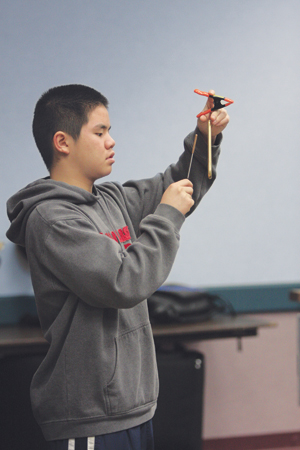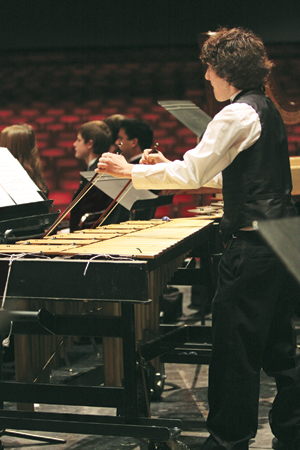Preparing an ensemble for performance is a daunting task and it is only natural that some things may be overlooked. In my experiences as a band director, percussionist, and adjudicator I have noticed a handful of percussion-specific items that are often disregarded which can be easily fixed and will make a big difference in the sound of the entire ensemble. While this is not meant to be an exhaustive list, addressing the problems outlined below will pay immediate dividends.
Crash Cymbals
Nothing changes the sound of an ensemble as much as a good pair of crash cymbals. When I taught high school I always put my best percussionist on cymbals for marches. The sound is extremely important. A brief survey of any major distributor will show that there are hundreds of different crash cymbals available with such names as French, Germanic, Viennese, Symphonic, or Concert. These names deal with thickness, weight, and tone color. A Germanic cymbal will sound dark and rich while French cymbals will be lighter and sound more delicate.
Ideally an ensemble should have at least three pairs of cymbals to choose from as is appropriate for the music. However, if there is only enough in the budget to buy one pair of cymbals, find a pair that is capable of producing several different sounds and colors. A good pair of crash cymbals can produce a huge variety of timbres, limited only by the imagination of the performer and conductor.
If I could only own one pair of cymbals, they would be 18" medium heavy or heavy Viennese or Germanic. These will work well for marches and allow for soft or loud crashes. The second pair I would purchase would be light 16" French cymbals for soft crashes. These could double as suspended cymbals if necessary. My third pair would be 20" heavy cymbals for big, cadential crashes.
To find the best cymbals, take a trip to a local music dealer and ask someone (preferably a percussionist) to play several pairs while you stand several feet away and listen. Ask for both loud crashes and soft, and listen for the colors in the ring and for how long the sustain lasts. Good cymbals should produce a wide variety of overtones. Also, longer rings are better. Such instruments can be dampened if the sound must be cut off, but it is impossible to extend the ring time of cymbals that decay quickly.
Listen for the initial attack; some instruments produce a big crash while others may only give out a splash. Also listen to whether the ring has the same sound color as the attack. Have the demonstrator play several notes in rapid succession to see whether you hear each attack or they start blending together. Are they too big for your students to handle comfortably or too small to be heard through your ensemble?
When listening to a professional recording, pay close attention to the different sounds coming from the cymbal players. Do not hesitate to call a local professional or college percussion instructor to ask about equipment. Percussionists are notorious for being picky about their equipment, and for loving to talk about it with anybody who will listen.
Triangles
 I have heard far too many otherwise carefully detailed performances considerably diminished by poor quality triangles. Just as a student-model clarinet sounds significantly different from a professional instrument, a cheap triangle sounds like a lead pipe when compared to a carefully crafted model. Much like cymbals, a good triangle should be able to produce a wide variety of tones and ring for at least four seconds. An instrument that gives anything less should not be considered.
I have heard far too many otherwise carefully detailed performances considerably diminished by poor quality triangles. Just as a student-model clarinet sounds significantly different from a professional instrument, a cheap triangle sounds like a lead pipe when compared to a carefully crafted model. Much like cymbals, a good triangle should be able to produce a wide variety of tones and ring for at least four seconds. An instrument that gives anything less should not be considered.
The beater is important, but the world’s best beaters cannot make a bad triangle sound good. On the other hand, I have heard very good triangles sound wonderful when played with a large nail. Any percussionist will be happy to share opinions, but in the end trust your ear to get the sound you like. If I only owned one triangle it would be 6". After that I would choose an 8" or 9" triangle that sounded noticeably different from the first one.
Mallet Selection
In his book Effective Performance of Band Music Francis McBeth wrote, “Whenever a mallet note is written, it is to be the predominant sound heard by the audience.” In the 40 years since that book was written, mallet writing has grown exponentially and it is now common to have glockenspiel, vibraphone, xylophone, marimba, and chimes featured as prominently as clarinets and trumpets.
However, I still regularly attend performances where I see players striking the instruments but cannot hear a single note coming out of them. There are two reasons for this. First, players and conductors tend to take dynamics too literally. If a composer writes a p for a marimba part, the intention is for the audience to hear it at a piano dynamic. In order for that to happen the player may have to play at a mp, mf, or possibly even f. If the conductor cannot hear the part clearly there is almost no chance that the audience will.
Second, mallet selection is often problematic. Budgets can be tight, but purchasing appropriate mallets for keyboard percussion instruments is a worthy investment. If you do not trust students to care for them properly, simply insist that they be returned to you after class every day and stored in your office, but do not have students rehearse with one set of mallets and perform with another. That would be akin to having the clarinet section rehearse on #2 reeds and then use #4s for the concert.
At a minimum, a well-stocked mallet selection will include the following:
2 pairs of hard rubber/plastic/ acrylic that can be used for xylophone and glockenspiel
1 pair of brass mallets that should be used on glockenspiel only
1 pair of medium hard and 1 pair of hard vibraphone mallets
1 pair of medium hard and 1 pair of hard marimba mallets (soft marimba mallets are wonderful for solo playing, but nearly impossible to hear over a band)
1 pair of multi-use (two-headed) chime mallets
 Many (if not all) contemporary composers feel the same way as McBeth. When asked his opinion, John Mackey replied, “I completely agree with McBeth. If I write a note on the page, I want to hear it. With mallets, this is especially true because the colors are so unique. In Aurora Awakes, one of the biggest problems in performance is that the 16th-note vibraphone ostinato gets covered up, but I never want that to happen. If I ask for bowed vibraphone, I really need to hear it, because the bowed attack within a wind ensemble will change the perceived attack of an entire chord throughout the ensemble, tricking the ear, for at least a moment, into thinking you’re hearing a string section. If you cover up that bowed attack, the effect is lost. I also can’t tell you how crazy it makes me when I write a bowed vibe, crotale, or marimba part only to hear it played with a mallet because the player either doesn’t have a bow or is uncomfortable bowing. Playing a bowed part with a mallet is just as wrong as playing a bass drum roll with a pair of triangle beaters.”
Many (if not all) contemporary composers feel the same way as McBeth. When asked his opinion, John Mackey replied, “I completely agree with McBeth. If I write a note on the page, I want to hear it. With mallets, this is especially true because the colors are so unique. In Aurora Awakes, one of the biggest problems in performance is that the 16th-note vibraphone ostinato gets covered up, but I never want that to happen. If I ask for bowed vibraphone, I really need to hear it, because the bowed attack within a wind ensemble will change the perceived attack of an entire chord throughout the ensemble, tricking the ear, for at least a moment, into thinking you’re hearing a string section. If you cover up that bowed attack, the effect is lost. I also can’t tell you how crazy it makes me when I write a bowed vibe, crotale, or marimba part only to hear it played with a mallet because the player either doesn’t have a bow or is uncomfortable bowing. Playing a bowed part with a mallet is just as wrong as playing a bass drum roll with a pair of triangle beaters.”
Performance Practices
The mistake that bothers me more than any other is when cymbal players play a choke by hitting the two plates together and leaving them there. While this is a widely used and accepted technique in the marching and indoor percussion worlds it is entirely incorrect in concert performance. The correct technique for playing a choke is to perform a normal crash and then dampen the cymbals immediately into the stomach. This allows the cymbals to actually produce an acceptable tone before being dampened; the brief instant of ring before the stop is crucial. A perfect example would be the two sword-fighting scenes in Tchaikovsky’s Romeo and Juliet Overture-Fantasy. The only time the cymbals should remain touching each other is when the composer writes “ala hi-hat” or “plates together” in the part.
When playing cymbals, triangle, tambourine, cabasa, whip, or practically any instrument that does not sit on the floor or on a stand, percussionists should hold the instrument high enough to be seen by the audience and to project over the wind and string players. Not only does that allow the sound to cut through the ensemble, but it also helps with technique and is visually appealing as well.
Finally, although this is not often discussed, facial expressions matter. While almost everybody else in the band has a horn blocking their lips, this is obviously not true with the percussionists. As a judge, conductor, and audience member I much prefer watching percussionists who are engaged and animated than those who look bored or uninvolved. I’m not asking that they channel Jim Carrey, but simply that they appear to enjoy what they are doing and are absorbed in the music they are producing.
Percussionists can only add the interesting colors, textures, and visual enhancement unique to their instruments if given the correct implements to do so. Directors who provide high-quality cymbals, triangles, and mallets for their players, and who are clear with their expectations will reap the rewards of more vibrant timbres, more engaged players, and more exciting performances





